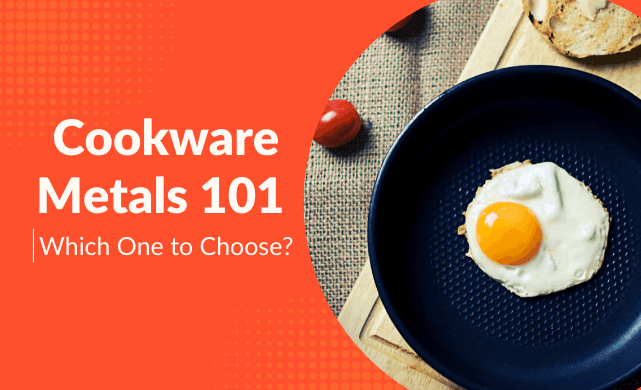Commercial cookware comes in a large variety of sizes, shapes, styles, materials, and applications. All of which must be taken into consideration when selecting the right cookware for your foodservice establishment. The different metal materials available for cookware each have a distinctive purpose, but the two most common used in commercial cookware are aluminum and stainless steel. Below you can see the most popular metals for cookware in the market:
Stainless Steel:
Knowing when to use your commercial stainless-steel cookware can be a game-changer for many cooks who frequently find themselves creating dishes that include acidic foods and ingredients. The biggest selling point of stainless steel is that it is resistant to acid. Unlike aluminum, a stainless-steel pan won’t discolor delicate sauce, because stainless steel is non-porous. It is important to always have stainless steel cookware as part of your kitchen’s arsenal for acidic foods such as tomato sauces, vinegar-heavy marinades, and citric glazes. Unfortunately, stainless steel is a poor conductor of heat, it provides inconsistent heat distribution, and it has a longer heat-up time than aluminum and copper.
Aluminum:
Aluminum pans are lightweight, affordable, and very good at distributing heat. Aluminum doesn’t retain heat particularly well though, so the temperature will fluctuate as food is added to a hot pan. It is also a softer metal, so it will scratch and dent easily. Unlike stainless steel, natural aluminum will react with certain acidic foods, imparting a metallic taste and dull gray tint. Which is why restaurant quality aluminum cookware is often enhanced with various coatings that provide properties such as non-stick and durability. Because aluminum is lightweight, it makes a practical choice for larger pieces like roasting pans, sheet pans, griddles, and large water pots.
Carbon Steel:
Commercial carbon steel cookware has most of the benefits of cast iron at a fraction of the weight. Foodservice facilities have been using carbon steel for years to prepare many dishes. Today, more chefs and prep cooks are using carbon steel for its wider range of advantages such as searing, oven-safe convenience, and ability to heat up and cool down quickly for more delicate foods. Seasoned carbon steel affords the benefits of non-stick without Teflon materials. If it is seasoned properly, it will develop a naturally nonstick interior, similar to cast iron, making carbon steel cookware highly versatile. Some of the cons of carbon steel are that it requires more diligence to maintain proper seasoning, it’s recommended to avoid acidic foods, and it doesn’t maintain high heat like cast iron.
Cast Iron:
Anyone who cooks consistently with commercial cast iron cookware will swear by its incomparable ability to cook and fry a wide variety of foods while giving them a great, crisp texture. Cast Iron cookware is exceedingly durable and resist warping, denting, and chipping. Available in its natural state or enamel coated and both cook similarly but there are other notable differences. Contrary to popular belief, cast iron is not great at distributing heat. It’s better than stainless steel or carbon steel, but not as effective as aluminum or copper. Cast iron pans require extra attention and care when you add them to your kitchen, even if you’ve purchased a “pre-seasoned” cast iron platter or skillet, it is recommended that you always take the time to properly season your cookware. Additionally, unlike stainless steel, cast iron will rust if left exposed, and it’s reactive with acid, like aluminum and copper.
Copper:
Copper is the best heat conductor of any material used to make cookware. It heats rapidly and evenly and cools down as soon as it's removed from the heat, giving you maximum control over the application of heat. Unlike aluminum, copper is extremely dense, which makes it durable and long-lasting, however, copper cannot be used alone for most cookware applications because it reacts with the natural minerals and acids of many foods, in a similar fashion as aluminum. Because of this, copper is traditionally lined with tin or stainless steel. Additionally, adding commercial copper cookware to your kitchen often comes at a financial investment, however many cooks will claim the results are well worth it.
Each restaurant and every cook has a unique cooking style and every menu might require different cookware. Equipping your foodservice facility with a wide range of pots and pans can make all the difference. If you have any further questions, feel free to contact us to speak to one of our experts to help you make the best decision.
